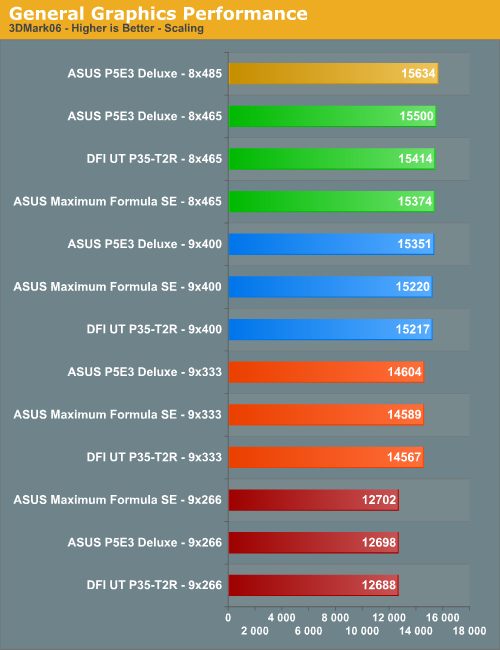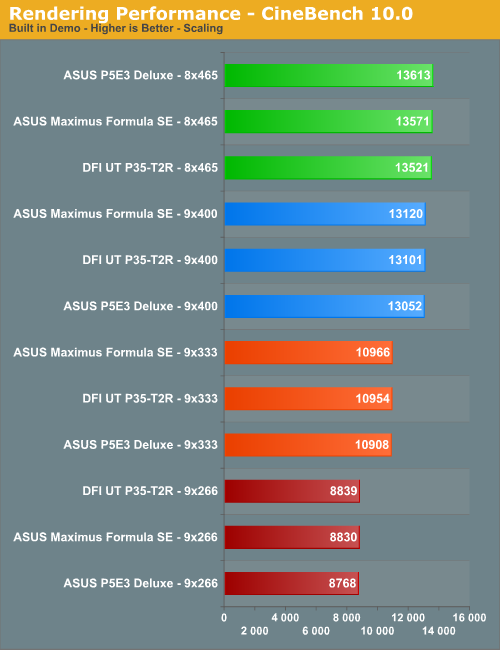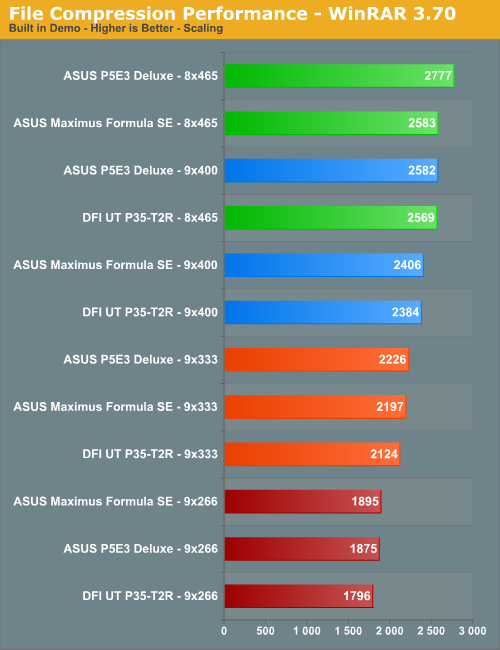ASUS P5E3 Deluxe Overclocking: DDR3 Takes Front Stage
by Kris Boughton on November 20, 2007 4:00 AM EST- Posted in
- CPUs
Overclocking Performance Comparison
All results were taken running memory ratios of 2:1 for final DRAM speeds of DDR-1066 @ 4-4-4-12, DDR-1333 @ 5-5-5-12, DDR-1600 @ 6-6-6-15, and DDR-1860 @ 8-8-8-15, respectively. This way we are able to capture any performance gain possible by taking advantage of the increased memory bandwidth provided by the DDR3 memory. Obviously, the DDR2 used in the testing of the ASUS Maximum Formula SE and the DFI UT P35-T2R needed to make use of lower dividers in order to maintain memory frequency within an achievable range.
Synthetic Graphics Performance

A close examination of the graphics results leads us to believe that, while nice to look at, DDR3 will do little to nothing in improving your overall gaming experience. This should come as no big surprise to anyone as we've known for a while that today's games are very much GPU dependent, especially at higher resolutions. The large performance gain in 3DMark06 seen when overclocking from 9x266 to 9x333 is a strong indication that the system was previously bottlenecked by the CPU when running at the stock 2.4GHz speed. Once we eclipse the 3GHz barrier though we start to see ever diminishing returns as we continue to push the processor higher and higher. This tells us that the system has now become GPU-bound and we can attribute any small gains in scores to the points we gain in the two CPU tests alone. Although the ASUS P5E3 Deluxe did manage to maintain a small lead across all phases of the graphics testing, the difference is hardly sizeable enough to justify the cost of DDR3, although this board will allow you to extract its full potential.
CPU Performance

We chose Super PI for testing the CPU/memory subsystem performance. Rather than run short sub-15 second tests that didn't do much to stress the memory we opted to run the longer 32M test. Small gains of approximately 1-3% are hardly groundbreaking. Nevertheless, the ASUS P5E3 Deluxe managed to maintain the performance lead in all test runs. The largest single score improvement was achieved during the 9x400 run with the MCH performance-optimized using a Static Read Control Delay of 6. In this case, tightening the sub-timings and setting Command Rate 1N may have been enough to bring the total time down to less than 800 seconds. We will continue testing this DDR3 and report additional results later.
Rendering Performance

CINEBENCH R10 is a great all-out CPU performance benchmark that scales wonderfully with the number of CPU cores in the system. As such, there is little to no gain seen by running the higher memory speeds provided by our DDR3. We will include Intel 45nm quad-core results in the next article.
File Compression Performance

Judging by the results of the built-in file compression benchmark provided in WinRAR 3.70 there is some additional performance available by providing the CPU with additional bandwidth - this makes sense, as file compression is quite data intensive, especially considering the amount of memory flip operations performed by this program. Here we see a solid 7% performance lead by the ASUS P5E3 Deluxe when running at 8x465.
All results were taken running memory ratios of 2:1 for final DRAM speeds of DDR-1066 @ 4-4-4-12, DDR-1333 @ 5-5-5-12, DDR-1600 @ 6-6-6-15, and DDR-1860 @ 8-8-8-15, respectively. This way we are able to capture any performance gain possible by taking advantage of the increased memory bandwidth provided by the DDR3 memory. Obviously, the DDR2 used in the testing of the ASUS Maximum Formula SE and the DFI UT P35-T2R needed to make use of lower dividers in order to maintain memory frequency within an achievable range.
Synthetic Graphics Performance

A close examination of the graphics results leads us to believe that, while nice to look at, DDR3 will do little to nothing in improving your overall gaming experience. This should come as no big surprise to anyone as we've known for a while that today's games are very much GPU dependent, especially at higher resolutions. The large performance gain in 3DMark06 seen when overclocking from 9x266 to 9x333 is a strong indication that the system was previously bottlenecked by the CPU when running at the stock 2.4GHz speed. Once we eclipse the 3GHz barrier though we start to see ever diminishing returns as we continue to push the processor higher and higher. This tells us that the system has now become GPU-bound and we can attribute any small gains in scores to the points we gain in the two CPU tests alone. Although the ASUS P5E3 Deluxe did manage to maintain a small lead across all phases of the graphics testing, the difference is hardly sizeable enough to justify the cost of DDR3, although this board will allow you to extract its full potential.
CPU Performance

We chose Super PI for testing the CPU/memory subsystem performance. Rather than run short sub-15 second tests that didn't do much to stress the memory we opted to run the longer 32M test. Small gains of approximately 1-3% are hardly groundbreaking. Nevertheless, the ASUS P5E3 Deluxe managed to maintain the performance lead in all test runs. The largest single score improvement was achieved during the 9x400 run with the MCH performance-optimized using a Static Read Control Delay of 6. In this case, tightening the sub-timings and setting Command Rate 1N may have been enough to bring the total time down to less than 800 seconds. We will continue testing this DDR3 and report additional results later.
Rendering Performance

CINEBENCH R10 is a great all-out CPU performance benchmark that scales wonderfully with the number of CPU cores in the system. As such, there is little to no gain seen by running the higher memory speeds provided by our DDR3. We will include Intel 45nm quad-core results in the next article.
File Compression Performance

Judging by the results of the built-in file compression benchmark provided in WinRAR 3.70 there is some additional performance available by providing the CPU with additional bandwidth - this makes sense, as file compression is quite data intensive, especially considering the amount of memory flip operations performed by this program. Here we see a solid 7% performance lead by the ASUS P5E3 Deluxe when running at 8x465.










25 Comments
View All Comments
frede86 - Tuesday, September 2, 2008 - link
hey folksnice guide u made there m8.
but ive tryed to use that setup u recomment.
but doenst work. how come? is it because i use a dou core E8500?
Cheers
frede86 - Tuesday, September 2, 2008 - link
Core 2 dou*cEvin Ki - Saturday, February 23, 2008 - link
after reading the information on the AI transaction booster, and the Memset program, i decided to brave up, and give it a go. Memset indicated that my performance level was a 7. as my ddr2 CAS was 4, i assumed that the bios was relaxing my system a little. i simply disabled the booster option in bios with a relax of zero. rebooted, and re-ran Memset. nothing had changed. still a 7. any settings other than disabled and zero, in bios, will not POST. Memset allowed me to change the performance level to 6, apply, and save the change. nothing has changed in bios as a result of that change.my question is, what am i doing wrong, as i would expect to have seen something different in Memset with changing the bios to disabled and in effect lessening the relax?
i apologize if i have somehow missed the whole point, and do not understand this memory tweaking concept.
thanks
jwigi - Thursday, February 14, 2008 - link
Hi I have a P5k Premium and the contact between the heatsinks and the board aren't very good, i was wondering what size of screw you used and also if you needed to put any springs on them, i'm thinking of doing the same 'mod' you've done in your article on my board...thanks
plextor10000 - Thursday, January 10, 2008 - link
I was already one day playing with the settings of the mainboard, first tried to boost the E6850 from default 3Ghz to 3.6 , but could not make it stable in benchmarksSwitched to the Q6600 - and followed the guide , decrease the voltage for the CPU to 1.375 , for safety .
After step by step, i increased from 2.4 without any issue to 3.6 , running stable with my patriot 1333 on 1600
Thank you for this guide. Can i use the same settings for the E6850 also , or do i modyfie some settings to blaze the clocks of it ??
Ryujin - Sunday, January 6, 2008 - link
I recently got this board, and after reading this article, I really want to follow the advice therein and remove the thermal pads underneath the heatpipes/heatsinks and replace them with thermal paste, and replace all the plastic push-pins with screws/nuts.I've yet to start fiddling with the board, as I am still waiting for the CPU to arrive. A few pieces of advice I was looking for to ease my mind though:
- Would I be mad using Arctic Silver thermal compound, considering conductivity issues? (I could get ceramique, which is non-conductive, but it'll take quite a while, through the channels I wish to use).
- What diameter / length screws do you recommend? I figure 10mm M3 screws with lock nuts should do the trick... If they're too long, I should be able to screw them in with the heads facing the MB-tray.
- I'm going with a liquid cooling solution for my CPU. The P5E3 Deluxe included two fans that can be placed atop the heatsinks surrounding the CPU-socket for just such an occasion. However, I suspect they're rather noisy (are they?). Also, the case I'm using is the Coolermaster Cosmos, which does have ample chassi fans, so I'm wondering it is really necessary (time will tell, but I was wondering if anyone has any opinions on the subject).
cheers
kmmatney - Tuesday, November 20, 2007 - link
OK, looking at the graphs, it just seems like all I'm seeing is the benchmarks getting better with higher overall cpu speed. The overclocking guide was good, but the benchmarks are hard to figure out, since memory speed and cpu speed are getting higher at the same time.kmmatney - Tuesday, November 20, 2007 - link
OK, figured it out - we just need to compare the Asus P5E3 scores versus the Asus Maximums scores at (8 X 465) to see how much DDR3 improves things over DDR2. Seems to be 1%-5%. Yawn...TA152H - Tuesday, November 20, 2007 - link
When I read the article for the x48, I mentioned that it made no sense for the three chipsets unless the x48 was DDR3 only. Well, I have found out from another site that it will be DDR3 only.That makes the x38 really only useful as a DDR2 chipset, after the x48 is available. This assumes Intel did the right thing of course, and all the ugly overhead for DDR2 is removed from the x48. But if it is, you'd have to be a fool to buy the x38 with DDR3, since it is second best, and has overhead from a function that will not be present on the motherboard. It will give you more heat, and more power use for something that is completely useless. I didn't like Intel including both, but I guess it was to transition to DDR3, so it was a necessary evil until the x48 comes out.
retrospooty - Friday, November 23, 2007 - link
actually, that isnt true. X48 is just an X38 selected out of speed bin to be the fastest. They were going to market it as only DDR3 (that was a marketing decision not a functionality decision) but have since changed their minds.http://www.fudzilla.com/index.php?option=com_conte...">http://www.fudzilla.com/index.php?optio...amp;task...
Either way your arguments are pretty one sided. Even with DDR3 highly overclocked to 2ghz its really only a slight bit faster then DDR2. In fact DDR2 at 1000mhz 4-4-4 beats DDR3 at 2000mhz @ 9-9-9 in most real world tests and apps. Intel is currently going with tri-channel DDR3 on the next gen CPU (nehalem) with internal memory controller. Then and ONLY then is DDR3 going to be worthwhile, and even then its only worthwhile because Nehalem chipsets wont support DDR2. DDR3 is a minor speed bump not worthy of spending money on until Nehalem comes out.